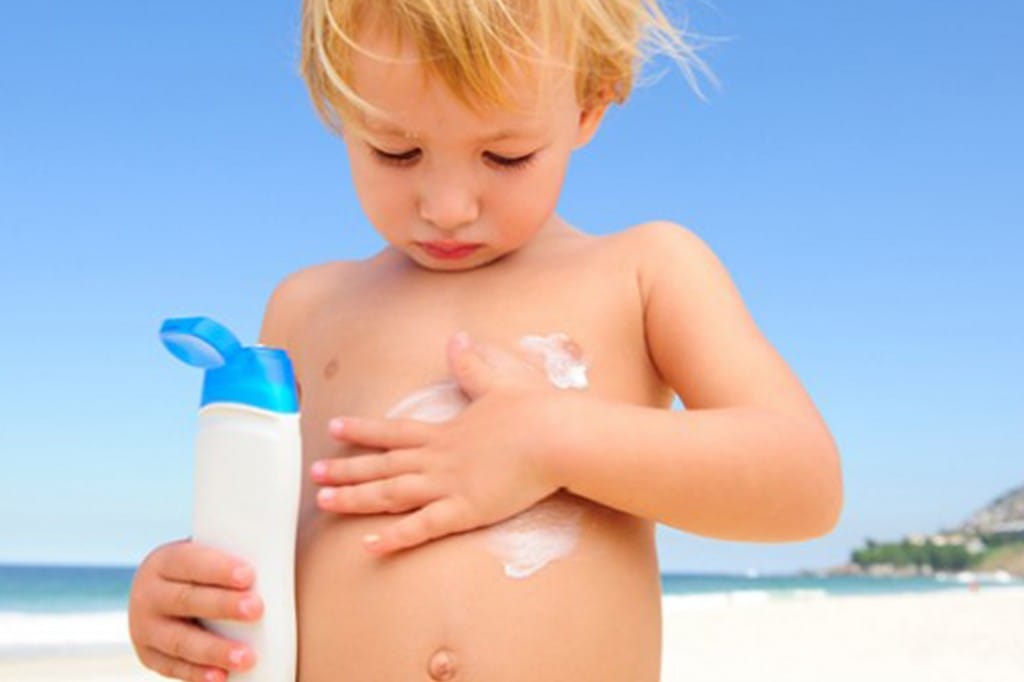
Why protect children’s skin from the sun?
Skin cancer is very serious and very common. The cause of most skin cancers is repeated exposure to the sun and sunburns year after year. When children learn at an early age how to properly protect their skin from the sun, they are more likely to continue doing so as they grow up, reducing their risk for skin cancer. Teaching children good sun habits is similar to teaching them to wear a seatbelt in the car or a helmet while riding a bike, reinforcing healthy habits at an early age.
What kind of damage does sun exposure cause?
Sun exposure and sunburns are major risk factors for most skin cancers, including melanoma, the deadliest form of skin cancer.
The sun’s energy which reaches earth contains rays of visible light and invisible (ultraviolet) light. There are two types of ultraviolet (UV) rays:
UVA and UVB. When UV rays hit the skin, they can damage skin cells, causing visible and invisible injuries. There is no such thing as safe UV rays.
UVA rays are the Aging rays that cause invisible damage to the skin. Some of the damage is reversible, but repeated exposure to UV can cause damage to skin cells that adds up over the years. After years of exposure, the built-up damage appears as wrinkles and age spots, and can lead to skin cancer.
UVB rays are the Burning rays that cause sunburn, a visible injury which appears just a few hours after unprotected sun exposure. In many people, UVB damage may result in a tan, which is the skin’s way of protecting itself from further injury. There is no such thing as a safe tan. Freckles, which occur in people with fair skin, are usually due to repeated sun exposure. Sunburn, suntan and freckles are signs of UV damage, and the need for sun protection.
UVB light is blocked by window glass, but UVA rays are able to pass through window glass, so people need to protect their skin every day of the year.
Without sun protection, people who spend time in the sun tend to develop tough, leathery skin that makes them look older than their actual age.
Large freckles (“age spots”), wrinkles, and scaly growths known as actinic keratoses, which are considered an early stage in the development of skin cancer, also can occur after a lifetime of UV exposure.
Which type of sun damage leads to skin cancer?
Basal cell carcinoma and squamous cell carcinoma are skin cancers that can develop in middle age and later in life, but can appear as early as the teenage years. These skin cancers are often slow growing and rarely spread to other parts of the body, but can do so. They also may cause severe damage to the surrounding skin, which could lead to possible disfigurement. Both basal and squamous cell carcinomas are very treatable when detected early.
Melanoma is the deadliest form of skin cancer. One person dies of melanoma every hour. Severe and repeated sunburns may be related to the development of melanoma. Melanomas can develop at any age, including children, teenagers and adults, and in people of all skin colors, even African Americans and Latinos. Melanomas can spread to other parts of the body and can be fatal.
Tanning beds produce the kind of ultraviolet light that can cause skin cancer and premature aging.
When should sun protection begin?
Sun protection should begin in infancy and continue throughout life. Damage by UV rays could become more severe with repeated exposure, so a lifelong habit of proper sun protection is important.
How can I protect my children from the sun?
Begin now to teach your children to follow the “ABCs for Fun in the Sun.”
• A= AWAY.
Stay away from the sun in the middle of the day.
• B =BLOCK.
Block the sun with protective clothing, seek shade, and apply a water-resistant sunscreen with a Sun Protection Factor (SPF) of at least 30 that provides broad-spectrum protection from ultraviolet A (UVA) and ultraviolet B (UVB) rays to all exposed skin.
• C = COVER UP.
Put on clothing, such as a T-shirt, swim shirt, long-sleeved shirts, pants, hats and sunglasses, when possible.
• S = SPEAK OUT.
Talk to family and friends about sun protection. Seek shade whenever possible.
For infants younger than 6 months, shade and protective clothing are the best ways to protect their skin. Use sunscreen on babies only if you cannot keep them out of the sun or cover their exposed skin.
Children and teens also should never use tanning beds. Talk with your children about the dangers of UV exposure from tanning of any kind.
What are the best ways to protect your skin from the sun?
Sun exposure is the most preventable risk factor for all skin cancers, including melanoma. Reducing sun exposure is an easy way to reduce your risk for skin cancer.

